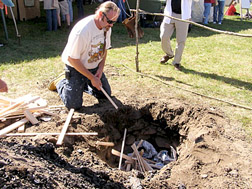 |
| Elliot Scott starts the fire on Friday for beans on Saturday. English photo. |
According to the Maine Folklife Center, Native Americans originated bean hole beans by baking beans with bear grease and maple syrup in clay pots covered with deerskins and buried in coals in the ground. The slow, long cooking makes the bean very digestible, tender and delicious.
Maine logging-camp cooks modified this process, adds the Folklife Center. The traditional bean hole is a stone-lined pit in which a fire is built until a good bed of coals forms. A cast iron bean pot is lowered into the pit, covered with soil and allowed to cook, usually overnight.
The tradition continues in the Folk Arts Area at the Common Ground Fair, where the process starts early in the week of the Fair as volunteers (this year Elliot Scott and Frank Cook) dig a hole about 3 feet deep and line it with rocks. The hole should allow for 5 or 6 inches of space around the pot after it’s lined.
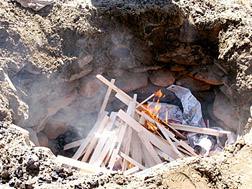 |
| The pit is lined with stones, and a fire is started hours ahead of the cooking time in order to prepare a bed of hot coals. English photo. |
“Rocks stacked like a stone wall are handy, but anything that holds the heat mass can be used,” says co-coordinator Vicky Burwell. “Some people have successfully used steel tire rims or scrap steel, including chains.”
Two days before the Fair, beans are parboiled for about an hour, then soaked overnight. On the day before the Fair, Scott started the fire very early in the morning. Burwell says that wood 2 to 3 inches in diameter will produce coals faster than big logs. “Leonard’s Mills [the Maine Forest and Logging Museum in Bradley, Maine] does bean-holes throughout the year and uses only this small size,” she notes. It may take about five hours to accumulate the needed 8 to 10 inches of coals before the hole is used.
Meanwhile, “all the usual ingredients” are added to the 11 pounds of Great Northern beans that have been soaked overnight and parboiled, says Burwell.
Those usual ingredients include:
5 lbs. salt pork or 1 lb. shortening
2. c. molasses
1 c. maple syrup
5 Tbsp. dry mustard
salt – 1/2 c. if salt pork was used; ¾ c. for the vegetarian pot.
2 Tbsp. pepper
5 of Peter Curra’s (of Curra Family Farm in Knox) onions, diced
Water to cover to a depth of about 2 inches.
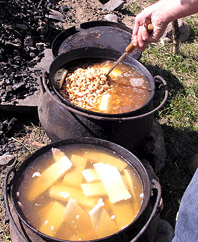 |
| Ingredients for baked beans are added and mixed. Volunteers make one pot for vegetarians and one for nonvegetarians. English photo. |
Set the pot of beans in the hole, heap hot coals around and over the pot, then shovel soil over the whole thing. About 22 hours later, the beans are ready.
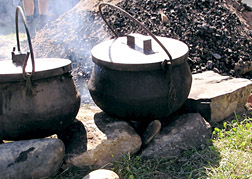 |
| The pots are ready to be put in the bean hole. These pots were generously provided by The Maine Forest and Logging Museum, Leonard’s Mills, Bradley, Maine. English photo. |
Dozens of Fairgoers enjoy a cup of the delicious baked beans around noon on each day of the Fair, as one large, cast-iron pot of traditional beans and one of vegetarian beans are lifted from the baking hole, set on a table and served by bean hole volunteers. The pots are generously loaned to the Fair each year by Leonard’s Mills.
“Pots can sometimes be found at yard sales,” Burwell continues, “or, here in Maine, in Uncle Henry’s. New pots can be purchased from Lehman’s Non-Electric Catalog (www.Lehmans.com). Their Camp Dutch Oven is just the thing and comes in several sizes.” She notes that home-sized pots need less cooking time – six to eight hours.
“Home adventurers will also need a hook of some sort to pull the pot out of the hole,” adds Burwell. “A fire poker would work with a little care.”
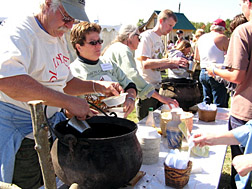 |
| Peter Rowell (left), Melissa Bastien, Vicky Burwell and Matt Pettengill serve beans to fairgoers. English photo. |
Burwell offers this recipe adaptation for the home cook:
1 pound beans (Navy, Pea, Yellow Eye, Marafax [a very old bean rescued by the late Pearl Smith of Unity and Burwell’s favorite] or Great Northern are all good)
1 pound salt pork or ½ cup shortening
¼ c. molasses
2 Tbsp. maple syrup
1 ½ tsp. dry mustard
¾ tsp. salt (for salt pork) or 1 tsp. salt for shortening
¼ tsp. pepper
½ medium onion, diced
Soak beans overnight, drain; cover with fresh water and simmer for about an hour (until bean skin “flays” when you blow on a bean). Combine with remaining ingredients; add boiling water to cover plus a little more (about ½ inch above level of beans after stirring). Cook in a slow cooker for 6 to 8 hours.
Here’s another recipe, distributed at the Folk Arts Area by the Maine Folklife Center:
Baked Beans
1 bag pea beans
2 onions, quartered
salt pork or 4 slices bacon, cut up
½ c. molasses
2 Tbsp. dry mustard
Soak beans overnight in large kettle; with liquid still in pan, bring to a boil, simmer for 1 hour; drain liquid into bowl and put beans in bean pot, add onion and salt pork or bacon; add remaining ingredients to bean liquid and then add back to beans; cover and bake for 6 hours at 325 degrees. (From Lumina (Cyr) Morin, Nos Histoires d l’Ile livre de cuisine: A Collection of Recipes from French Island in Old Town, Maine)
Bean Lingo
The Maine Folklife Center knows beans about beans – as evidenced by these traditional phrases that it defined at the Fair.
“Full of beans” – In good form or condition; as full of health, spirits, or capacity as a horse after a good feed of beans.
“Give a bean” – to chastise or berate
“To be like beans” – to be in good style, a general phrase of praise
“Not worth a bean” – to hold in little esteem; to be of little value.
“Beany” – to be in good humor.
“To know beans” – to be well informed, to be sharp or shrewd.

